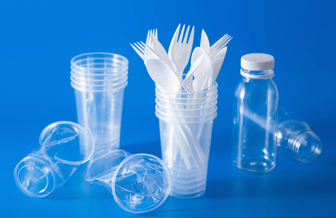 On May 2, 2023, the Environmental Protection Agency (EPA) published its “Draft National Strategy to Prevent Plastic Pollution,” and issued a formal request for public comments. EPA notes that over the last 20 years, the global annual production of plastic products has more than doubled, and that roughly 23% of global plastic waste is improperly disposed, burned, or leaked into the environment. North America both produces and consumes roughly 19% of global plastics. To address these issues, the Draft Strategy identifies a set of voluntary actions intended to reduce the volumes of plastic wastes the end up disposed or discarded within the US. EPA describes these measures, and the agency’s related activities, as “endeavors to provide an innovative, equitable approach to reduce and recover plastic and other waste, as well as prevent plastic pollution from harming human health and the environment, particularly for communities already overburdened by pollution.” The remainder of this note summarizes the 48 pages of the Draft Strategy.
On May 2, 2023, the Environmental Protection Agency (EPA) published its “Draft National Strategy to Prevent Plastic Pollution,” and issued a formal request for public comments. EPA notes that over the last 20 years, the global annual production of plastic products has more than doubled, and that roughly 23% of global plastic waste is improperly disposed, burned, or leaked into the environment. North America both produces and consumes roughly 19% of global plastics. To address these issues, the Draft Strategy identifies a set of voluntary actions intended to reduce the volumes of plastic wastes the end up disposed or discarded within the US. EPA describes these measures, and the agency’s related activities, as “endeavors to provide an innovative, equitable approach to reduce and recover plastic and other waste, as well as prevent plastic pollution from harming human health and the environment, particularly for communities already overburdened by pollution.” The remainder of this note summarizes the 48 pages of the Draft Strategy.
What strategic objectives does the Draft Strategy provide?
The new Draft Strategy sets out three Strategic objectives, and proposes Actions to be taken to further each objective. These consist of the following:
- Objective A: Reduce pollution during plastic production
EPA’s first proposed objective is to make changes in the design and production of items that presently contain plastic, reducing the “front end” of plastics flows. EPA describes this as “Designing products for reuse and recycling, using less impactful materials, phasing out unnecessary products, and ensuring proper controls at plastic production facilities are important upstream actions that manufacturers or consumers can take that can reduce pollution throughout the life cycle of plastic products.” The Draft Strategy provides two Proposed Actions:
- Reduce the production and consumption of single-use, unrecyclable, or frequently littered plastic products.
- Minimize pollution across the life cycle of plastic products.
- Objective B: Improve post-use materials management
The second proposed objective attends to improvements at end-of-life for products containing plastics. EPA describes this as “While EPA’s National Recycling Strategy identified actions to improve recycling, further increases in circularity can be achieved through other pathways, such as reuse, refill and composting.” (I discussed EPA’s National Recycling Strategy HERE). The new Draft Strategy provides six Proposed Actions:
- Conduct a study of the effectiveness of existing public policies and incentives upon the reuse, collection, recycling, and conservation of materials.
- Develop or expand capacity to maximize the reuse of materials.
- Facilitate more effective composting and degradation of certified compostable products.
- Increase solid waste collection and ensure that solid waste management does not adversely impact communities, including those overburdened by pollution.
- Increase public understanding of the impact of plastic mismanagement and how to appropriately manage plastic products and other waste.
- Explore possible ratification of the Basel Convention and encourage environmentally sound management of scrap and recyclables traded with other countries. (I wrote about the Convention HERE)
- Objective C: Prevent trash and micro/nanoplastics from entering waterways and remove escaped trash from the environment
This Objective seeks to ensure that plastics wastes are appropriately managed, rather than being intentionally or unintentionally released into the environment. EPA describes this as “Interventions to address trash and microplastics that escape into the environment are necessary for long-term reductions of plastic and other waste in waterways and oceans.” The new Draft Strategy provides five Proposed Actions:
C1. Identify and implement policies, programs, technical assistance, and compliance assurance actions that effectively prevent trash/microplastics from getting into waterways or remove such waste from waterways once it is there.
C2. Improve water management to increase trash capture in waterways and stormwater/wastewater systems.
C3. Increase and improve measurement of trash loadings into waterways to inform management interventions.
C4. Increase public awareness of the impacts of plastic products and other types of trash in waterways.
C5. Increase and coordinate research on micro/nanoplastics in waterways and oceans.
What information is EPA seeking via comments on its Draft Strategy?
Simultaneous with the release of the Draft Strategy, EPA has published a formal Request for Comments in the Federal Register. In the Request, EPA seeks answers to the following questions:
- Which actions are the most important and would have the greatest positive impact at the local, regional, national, and global levels? Consider:
- Which actions can best protect human health and environmental quality?
- Which actions are most important to address environmental justice and climate change?
- What are the key steps and milestones necessary to successfully implement the actions in the draft strategy?
- What are the most important roles and/or actions for federal agencies to lead?
- Is your organization willing to lead an action or collaborate with others to implement the actions?
- What factors would your organization consider when determining whether to lead an action?
- What are potential unintended consequences of the proposed actions that could impact communities considered overburdened or vulnerable, such as shifts in production or management methods?
- What key metrics and indicators should EPA use to measure progress in reducing plastic and other waste in waterways and oceans?
- What criteria should processes meet to be considered “recycling activities” (e.g., “plastics-to-plastics outputs are ‘recycling’ if these processes reduce the life cycle environmental impacts in comparison to traditional mechanical recycling”)?
- Are there other actions that should be included in the Strategy?
- Should EPA expand the scope of the strategy to include sea-based sources?
- Should specific types of plastic products be targeted for reduction or reuse in this strategy?
- Do you have any additional information or recommendations for EPA regarding these or other proposed actions in the draft strategy?
What’s next?
Comments are due by June 16, 2023. EPA will evaluate the comments, and consider whether to make changes in the Draft Strategy. EPA may then issue a revised draft, or proceed to issue a final strategy. Note that many of the proposed actions are already under way, so any further changes are likely to reflect adjustments and amplification.
Self-assessment checklist
Does the organization produce and sell plastics products that leave wastes after end users finish with them?
If so, has the organization evaluated the volumes of such wastes, and methods available for their management?
Has the organization assumed any post-use responsibilities for such wastes?
Has the organization evaluated whether changes in design or packaging might reduce post-consumer wastes?
Do the organization’s activities include use of plastic input materials that produce waste streams?
If so, has the organization identified wastes that are subject to specific recycling, recovery or stewardship programs applicable in one or more jurisdictions?
If so, has the organization evaluated its purchasing, to identify materials that produce these wastes?
If so, has the organization evaluated the suitability of available alternatives that would not produce wastes subject to these programs?
Has the organization established onsite collection of targeted materials, and delivery of those materials to available destinations (solid waste pick-up, return to retailer, etc.)?
Does the organization track legislative and regulatory processes in order to stay informed about possible changes in applicable waste management requirements, including EPA’s continuing development and implementation of the National Strategy to Prevent Plastic Pollution, and more generally of EPA’s National Recycling Strategy?
Where can I go for more information?
- EPA
- Draft National Strategy to Prevent Plastic Pollution webpage
- “Recycling Strategy” webpage
- “Reduce, Reuse, Recycle” webpage
- 2021 national Recycling Strategy
- Request for comments, Draft Strategy (5/2/23 Federal Register)
About the Author
 Jon Elliott is President of Touchstone Environmental and has been a major contributor to STP’s product range for over 30 years.
Jon Elliott is President of Touchstone Environmental and has been a major contributor to STP’s product range for over 30 years.
Mr. Elliott has a diverse educational background. In addition to his Juris Doctor (University of California, Boalt Hall School of Law, 1981), he holds a Master of Public Policy (Goldman School of Public Policy [GSPP], UC Berkeley, 1980), and a Bachelor of Science in Mechanical Engineering (Princeton University, 1977).
Mr. Elliott is active in professional and community organizations. In addition, he is a past chairman of the Board of Directors of the GSPP Alumni Association, and past member of the Executive Committee of the State Bar of California's Environmental Law Section (including past chair of its Legislative Committee).
You may contact Mr. Elliott directly at: tei@ix.netcom.com
